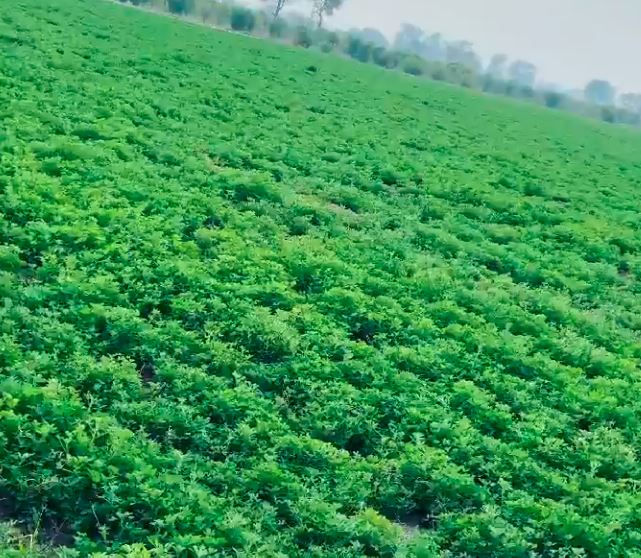Lucerne Seed Price per Kg (2025 Update)
- BeyondForest

- Nov 28, 2024
- 8 min read
Updated: May 29

7.)Advantages of Lucerne
8.)Disadvantages of Lucerne
Alfalfa is a perfect habitat for an enormous diversity of insect species. Scientists have observed over 1000 species of insects and other arthropods (including mites, spiders, etc.) living or feeding in alfalfa fields.

Image of a post by Kibois breeders around Lucerne
Lucerne scientifically known Medicago sativa and also known as alfalfa is a versatile and valuable legume crop that is grown primarily for its high nutritional content and is mainly used as forage for livestock.
More cuts = higher yield of fodder per year means thus better returns for farmers because Lucerne is a high-protein, nitrogen-fixing legume that boosts milk and meat production.

This nitrogen contribution, as well as alfalfa’s weed- and pest-suppressive abilities, make it an especially valuable crop for farmers using integrated pest management or organic practices.

Image of Lucerne Flowers by tribepermaculture
Its importance in the agricultural sector cannot be overstated, as it serves as a vital feed source for dairy and beef cattle, as well as for sheep, goats, and horses. Additionally, alfalfa is increasingly used as a cover crop, soil conditioner, and in some cases, for medicinal purposes due to its rich nutrient profile .
Lucerne Yellowing is caused due to lack of Boron

Lucerne is the term predominantly used in Europe, Australia, and parts of Africa. The name "Lucerne" originates from the French word luzerne, which refers to the place in Europe where it was first cultivated, Lucerne in Switzerland. Over time, the term "Lucerne" became common in many countries outside North America . Alfalfa is the term used in North America and South America.

Image of Lucerne Pellets Marula Estates Dairy Farm
Alfa alfa roots extend up to 16 feet into the soil, much deeper than other crops. The deep root system holds the soil and creates channels that promote water infiltration, biological activity in the root zone and Improved nutrient cycling

The word "Alfalfa" comes from the Arabic al-fac-facah, meaning "father of all foods," a reference to its nutritious value. The name reflects the plant's ancient use in the Mediterranean and Middle Eastern regions before being introduced to the Americas. Despite the difference in naming conventions, Lucerne and Alfalfa refer to the same plant species, Medicago sativa.

Alfalfa, often referred to as the "queen of forages," has been cultivated for centuries due to its high feed value. It is a member of the pea family (Fabaceae) and is native to Asia and the Mediterranean region but has been widely adopted in temperate regions around the world, including the United States, Argentina, and parts of Africa, including Kenya. Alfalfa is highly nutritious, providing protein, fiber, and various vitamins and minerals essential for livestock.

Image of lucerne pellets
Alfalfa is grown for various purposes: as hay, silage, or green chop, and in some cases, its seeds are harvested for use as sprouts. Alfalfa is also important for crop rotation because of its ability to fix nitrogen in the soil, which enriches the soil and reduces the need for synthetic fertilizers.
Pasture legumes form a symbiotic (mutually beneficial) association with specific soil bacteria (rhizobia) to meet their nitrogen requirements. Nodules develop on the plant roots and house millions of rhizobia that convert nitrogen from the air into a form the plant can use in a process known as nitrogen fixation.- Davis Mugera
Struggling To Grow Your Business?
Scale By Running Facebook and Instagram Ads Like This .

📩 Fill the form below to get your free consultation or demo report.
📞 Prefer WhatsApp? Click Here
Delight Lucerne is a high yielding perennial tropical lucerne high germination rate gives 6*8 cuts per year. cutting intervals 20-30days first cutting about 2-3 months. tolerance to root rot and endophytes. High levels of protein (20-25%)
1 Kilogram Delight Lucerne High Protein Legume | 3000Ksh |
250 grams Delight Lucerne High Protein Legume | 900Ksh |
500 grams Delight Lucerne High Protein Legume | 1700Ksh |
250 grams Simlaw Pasture Legume Lucerne Seeds | 1300Ksh |
1 Kilogram Simlaw Lucerne Pasture Legume Seeds | 3300Ksh |
20 Kilogram Lucerne Pellets | 2700Ksh |
25 Kilogram Pure lucerne/alfalfa hay | 350Ksh |
50 Kilogram Lucerne pellet | 3500Ksh |
20 Kilogram Lucerne pellet | 1400Ksh |
1 Kilogram Lucerne Pellets | 70Ksh |
1 Kilogram Lucerne Seeds | 1150Ksh |

David | 0717 403 637 |
Happy Heart Enterprise | 0795787508 |
AECARE Agrochemicals | 0724933554 |

Image of Lucerne Hay by Solai Farm
Davis Mugera | 0722362981 |
Solai Farm | 0784879176. |
Marula Estates Dairy Farm | 0102392626 |
Can Lucerne be eaten by humans?
Lucerne (alfalfa) is not commonly eaten by humans as a whole plant but its sprouts are edible and used in salads and sandwiches. These sprouts are rich in vitamins A, C, K, and minerals. However, raw sprouts should be consumed in moderation due to potential digestive or hormonal effects.

Image of Lucerne Sprouts by mg_cist
What is the local name for Lucerne
The local name for Lucerne in many parts of Kenya is “Alfafa” or “Mlucerne”, though it is also commonly referred to as “Ng’wasi” in some local languages, especially among pastoral communities. While not all regions have a specific indigenous name, farmers often recognize it as a high-protein fodder crop used for feeding dairy cows, goats, and other livestock.
How long does it take lucerne to grow?
Lucerne's deep roots help it thrive for 3 to 5 years, making it a long-term, high-yielding forage crop when well managed.
Lucerne (alfalfa) typically takes 7 to 10 days to germinate after planting, depending on soil moisture and temperature. The first full harvest can be done around 60 to 75 days after sowing. Once established, Lucerne grows quickly and can be harvested every 4 to 6 weeks, producing multiple cuts per year up to 8 harvests annually under good conditions.
How many kg of Lucerne seed per acre?
To plant one acre of Lucerne (alfalfa), you typically need 8 to 12 kilograms of seed, depending on the planting method and seed quality. If you're broadcasting, use around 10–12 kg/acre to ensure even coverage. For drilled or row planting, 8–10 kg/acre is usually sufficient, as placement is more precise.
Lucerne can be harvested 4 to 8 times per year, depending on climate, soil fertility, and irrigation. In well-managed, irrigated systems, it can be cut every 4 to 6 weeks. In rain-fed areas, harvests may reduce to 3–4 times annually. Regular cutting boosts regrowth and yield.
The best fertilizer for Lucerne is one rich in phosphorus (P) and potassium (K), as Lucerne fixes its own nitrogen through root nodules. A common recommendation is DAP (Di-Ammonium Phosphate) at planting, followed by top-dressing with SSP or NPK based on soil tests. Avoid high-nitrogen fertilizers.
Lucerne has a lifespan of 3 to 5 years, depending on soil fertility, climate, and management practices. With proper care—such as timely harvesting, weed control, and fertilization it can remain productive throughout this period. Over time, yields may decline, requiring replanting or crop rotation.
Lucerne is not ideal for intercropping because it requires full sunlight and space to establish a deep root system. However, it can sometimes be grown with grasses like boma rhodes
What is the price of Lucerne?
The current price of Lucerne as of May 2025 is 400Ksh per bale with a bale weighing 18-25 kilograms while the Lucerne seeds cost 1250Ksh per Kilogram

Image of Lucerne Hay by Solai Farm
Deep fertile and free-draining soils with little or no murram or small rocks is ideal for lucerne growth. Farmers interested in growing alfalfa grass should have their soil tested for acidity before planting. The soil samples should be taken from the top (0-10cm) and the subsoil(30-40cm). The soil PH should be neutral up to 5.6. If the sub-soil sample has a PH of less than 5.5, it is considered too acidic and unsuitable for growing lucern -Aecare Agrochemicals
1. Site Selection
Lucerne grows best in temperate to warm climates with moderate rainfall (400–800 mm annually) and Prefers deep, well-drained loamy or sandy soils with a pH between 6.0 and 7.5.lucerne is sensitive to poor drainage thus one should avoid water logged areas
2. Land Preparation
Plow the field to a depth of 20–30 cm to loosen the soil. Harrow to break up clods and create a fine tilth. Ensure the land is leveled to prevent waterlogging.
3. Soil Testing and Liming
Test soil for pH and nutrients. If pH is below 6.0, apply lime 2–3 months before planting to reduce acidity.
4. Seed Selection and Inoculation
Choose certified, disease-free Lucerne seed. Inoculate seeds with Rhizobium meliloti (a nitrogen-fixing bacteria) just before planting for improved root nodulation and nitrogen fixation. (Optional)

Image of Inoculant for Legumes, Beans, Lucerne by Davis Mugera
Inoculate (in agriculture) means treating seeds with beneficial microorganisms, usually nitrogen-fixing bacteria, before planting.
For example, when growing legumes like Lucerne (alfalfa), farmers inoculate the seeds with a specific type of bacteria (e.g., Rhizobium meliloti). These bacteria help the plant capture nitrogen from the air and convert it into a form the plant can use, reducing the need for chemical fertilizers.
5. Planting
Best time to plant is early rains or just before the rainy season begins. The seedling rate is 8–12 kg/ha for broadcasting; 5–8 kg/ha for row planting Maintain as Spacing of 20–30 cm between rows; 2–5 cm between plants. Sow seeds shallowly (1–2 cm deep), as they are small and need light to germinate.
6. Fertilization
Apply phosphorus and potassium based on soil test results. Typical recommendation 20–40 kg/ha of P and 40–60 kg/ha of K at planting. Avoid high nitrogen fertilizers as Lucerne fixes its own nitrogen.
7. Irrigation (if applicable)
Water lightly and frequently during germination. Once established, water every 7–10 days in dry areas to maintain yield.
8. Weed Control
Weed frequently during early growth stages.Avoid chemical herbicides in young stands unless they’re lucerne-safe. Mulching can help suppress weeds naturally.
9. Harvesting
Avoid cutting your Lucerne too low (not below 5 cm) to allow regrowth from crown buds.

First cut of Alfa alfa is 60–75 days after planting or when 10% of plants are flowering. Subsequent cuts: Every 4–6 weeks.
10. Management and Longevity
Lucerne can last 3–5 years with good care. One should Rotate after productivity declines, and reseed if needed. Practice pest and disease monitoring, especially for aphids, weevils, and root rots.

Alfalfa grass does well in a warm and sunny climate with well-distributed rainfall of more than 1200mm annually. The grass may require supplementary irrigation under prolonged dry spells.
Lucerne Pest and Disease Management
Alfalfa is susceptible to various pests and diseases, which can impact yield and quality.
Pests
Alfalfa Weevil
A primary pest, particularly during the early growth stages, which feeds on the leaves.
Aphids
These insects can stunt growth and transmit plant viruses.
Root Maggots
These pests damage the roots, affecting plant health.
Diseases
Downy Mildew
A fungal disease that affects the plant’s growth.
Fusarium Wilt
A soil-borne fungal disease that impedes water transport within the plant.
Rhizoctonia Root Rot
A fungal infection that causes root decay.
Disadvantages of Alfalfa Farming

Image of a Truck loaded with alfa alfa bales by hcmciftligi on IG
Water Requirements
In regions where water is scarce, irrigation can become costly. Alfalfa requires a consistent water supply for optimal growth, making it a resource-intensive crop in drought-prone areas.
Pests and Diseases
As mentioned earlier, alfalfa is susceptible to various pests and diseases, which can significantly affect yield and quality.
Labor Costs
Alfalfa requires multiple harvests per year, which means labor costs can be high, particularly for farmers who rely on manual labor for cutting and drying.
Soil Quality
While alfalfa improves soil fertility, it also requires a well-drained, fertile soil to thrive. Farmers in less-than-ideal soil conditions may struggle to produce high yields.





Comments